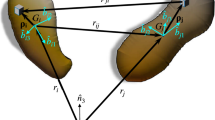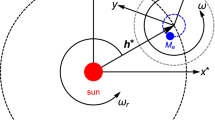Abstract
Coupling between the rotational and translational motion of a rigid body can have a profound effect on spacecraft motion in complex dynamical environments. While there is a substantial amount of study of rigid-body coupling in a non-uniform gravitational field, the spacecraft is often considered as a point-mass vehicle. By contrast, the full-N body problem (FNBP) evaluates the mutual gravitational potential of the rigid-body celestial objects and any other body, such as a spacecraft, under their influence and treats all bodies, including the spacecraft, as a rigid body. Furthermore, the perturbing effects of the FNBP become more pronounced as the celestial bodies become smaller and/or more significantly aspherical. Utilizing the comprehensive framework of dynamics and gravitational influences within the FNBP, this research investigates the dynamics of spacecraft modeled as rigid bodies in binary systems characterized by nearly circular mutual orbits. The paper presents an examination of the perturbation effects that arise in this circular restricted full three-body problem (CRF3BP), aiming to assess and validate the extent of these effects on the spacecraft’s overall motion. Numerical results provided for spacecraft motion in the CRF3BP in a binary asteroid system demonstrate non-negligible trajectory divergence when utilizing rigid-body versus point mass spacecraft models. These results also investigate the effects of shape and inertia tensors of the bodies and solar radiation pressure in those models.


















































Similar content being viewed by others
Data Availability
All data products included in this analysis are available upon request from the corresponding author.
References
Anderson, A., McCann, B., Canales, D., et al.: Orbit and attitude coupling in the full-higher fidelity ephemeris model within the context of the geometric mechanics framework. In: AAS/AIAA Spaceflight Mechanics Conference (2023)
Bellerose, J., Scheeres, D.J.: Restricted full three-body problem: application to binary system 1999 KW4. J. Guid. Control. Dyn. 31(1), 162–171 (2008). https://doi.org/10.2514/1.30937
Bolatti, D., de Ruiter, A.H.: Quantification of attitude effects on orbital dynamics near asteroids. Acta Astronaut. 167, 467–482 (2020). https://doi.org/10.1016/j.actaastro.2019.10.044
D’Amario, L., Bright, L., Wolf, A.: Galileo trajectory design. Space Sci. Rev. https://doi.org/10.1007/bf00216849 (1992)
Eberly, D.: Polyhedral mass properties (Revisited)—geometric tools. https://www.geometrictools.com/Documentation/PolyhedralMassProperties.pdf(2009)
Fahnestock, E.: The full two-body-problem: simulation, analysis, and application to the dynamics, characteristics, and evolution of binary asteroid systems. Ph.D. thesis, University of Michigan (2009)
Fahnestock, E.G., Scheeres, D.: Simulation of the full two rigid body problem using polyhedral mutual potential and potential derivatives approach. Celest. Mech. Dyn. Astron. 96(3–4), 317–339 (2006). https://doi.org/10.1007/s10569-006-9045-6
Farres, A., Folta, D., Webster, C.: Using spherical harmonics to model solar radiation pressure accelerations. Adv. Astronaut. Sci. 162, 3365–3383 (2018)
Gabern, F., Koon, W., Marsden, J., et al.: Binary asteroid observation orbits from a global dynamical perspective. SIAM J. Appl. Dyn. Syst. 5(2), 252–279 (2006). https://doi.org/10.1137/050641843
Hai-Shuo, W., Xi-Yun, H.: Forced hovering orbit above the primary in the binary asteroid system. Celest. Mech. Dyn. Astron. https://doi.org/10.1007/s10569-022-10098-0 (2022)
Jean, I., Misra, A., Ng, A.: Orbital and attitude coupled dynamics of a spacecraft around an asteroid. In: Third IAA Conference on Dynamics and Control of Space Systems (2017)
Jean, I., Ng, A., Misra, A.: Impact of solar radiation pressure modeling on orbital dynamics in the vicinity of binary asteroids. Acta Astronaut. 165, 167–183 (2019). https://doi.org/10.1016/j.actaastro.2019.09.003
Jean, I., Misra, A.K., Ng, A.: Controlled spacecraft trajectories in the context of a mission to a binary asteroid system. J. Astronaut. Sci. 68(1), 38–70 (2021). https://doi.org/10.1007/s40295-021-00248-1
Kallay, M.: Computing the moment of inertia of a solid defined by a triangle mesh. J. Graph. Tools 11(2), 51–57 (2006). https://doi.org/10.1080/2151237x.2006.10129220
Kikuchi, S., Howell, K., Tsuda, Y., et al.: Orbit-attitude coupled motion around small bodies: sun-synchronous orbits with sun-tracking attitude motion. Acta Astronaut. 140, 34–48 (2017). https://doi.org/10.1016/j.actaastro.2017.07.043
Knutson, A.: Application of Kane’s method to incorporate attitude dynamics into the circular restricted three-body problem. Ph.D. thesis, Purdue University, Indiana (2012)
Knutson, A., Guzzetti, D., Howell, K., et al.: Attitude responses in coupled orbit-attitude dynamical model in Earth–Moon Lyapunov orbits. J. Guid. Control Dyn. 38(7), 1264–1273 (2015). https://doi.org/10.2514/1.G000469
Lei, H., Circi, C., Ortore, E.: Secular dynamics around uniformly rotating asteroids. Mon. Not. R. Astron. Soc. 485(2), 2731–2743 (2019). https://doi.org/10.1093/mnras/stz561
Lubey, D., Kennedy, B., Roth, D., et al.: Development of a solar radiation pressure model for the dragonfly mission. In: AAS/AIAA Astrodynamics Specialist Conference (2022)
Margot, J.L., Pravec, P., Taylor, P., et al.: Asteroid systems: binaries, triples, and pairs. Asteroids IV https://doi.org/10.48550/arXiv.1504.00034 (2015)
McCann, B., Nazari, M.: Analysis of the impact of orbit-attitude coupling at higher-degree potential models on spacecraft dynamics. J. Astronaut. Sci. 69, 955–987 (2022). https://doi.org/10.1007/s40295-022-00335-x
McCann, B., Anderson, A., Nazari, M., et al.: Local stability of equilibria in the circular-restricted full three body problem. In: AAS/AIAA Astrodynamics Specialist Conference (2023a)
McCann, B., Anderson, A., Nazari, M., et al.: Rigid-Body Spacecraft Dynamics Analysis in a Binary System Using Formulation in Lie Groups. AAS/AIAA Spaceflight Mechanics Meeting, Austin, TX (2023)
Mirtich, B.: Fast and accurate computation of polyhedral mass properties. J. Graph. Tools 1(2), 31–50 (1996). https://doi.org/10.1080/10867651.1996.10487458
Montenbruck, O., Eberhard, G.: Satellite Orbits: Models, Methods, and Applications. Springer, Berlin (2013)
Mottola, S., Lahulla, F.: Mutual eclipse events in asteroidal binary system 1996 FG3: observations and a numerical model. Icarus 146, 556–567 (2000). https://doi.org/10.1006/icar.2000.6421
Nakano, R., Hirabayashi, M., Agrusa, H.F., et al.: NASA’s double asteroid redirection test (dart): mutual orbital period change due to reshaping in the near-Earth binary asteroid system (65803) didymos. Planet. Sci. J. 3(7), 148 (2022). https://doi.org/10.3847/psj/ac7566
National Academies of Sciences, Engineering, and Medicine (2022) Origins, Worlds, and Life: A Decadal Strategy for Planetary Science and Astrobiology 2023-2032. The National Academies Press, Washington, DC, https://doi.org/10.17226/26522, https://nap.nationalacademies.org/catalog/26522/origins-worlds-and-life-a-decadal-strategy-for-planetary-science
Nazari, M., Wauson, R., Critz, T., et al.: Observer-based body-frame hovering control over a tumbling asteroid. Acta Astronaut. 102, 124–139 (2014). https://doi.org/10.1016/j.actaastro.2014.05.016
Nazari, M., Canales, D., McCann, B., et al.: Full N-Body Problem in the Geometric Mechanics Framework and its Reduction to Circular Restricted Three-Body Problem. AAS/AIAA Astrodynamics Specialist Conference, Charlotte, NC (2022)
Nazari, M., Canales, D., McCann, B., et al.: Framework for the full n-body problem in se(3) and its reduction to the circular restricted full three-body problem. Celest. Mech. Dyn. Astron. 135(4) (2023). https://doi.org/10.1007/s10569-023-10156-1
Ostro, S., Margot, J., Benner, L., et al.: Radar imaging of binary near-Earth asteroid (66391) 1999 KW4. Science 314(5803), 1276–1280 (2006). https://doi.org/10.1126/science.1133622
Ostro, S.J., Benner, L.A.M.: Asteroid shape models (2018). https://echo.jpl.nasa.gov/asteroids/shapes/shapes.html
Qian, Y., Zong, K., Yang, X., et al.: Forced resonance orbit analysis of binary asteroid system with consideration of solar radiation pressure. Nonlinear Dyn. 109(3), 1399–1422 (2022). https://doi.org/10.1007/s11071-022-07464-w
Scheeres, D.: Stability of binary asteroids. Icarus 159, 271–283 (2002). https://doi.org/10.1006/icar.2002.6908
Scheeres, D.: Orbital motion in strongly perturbed environments: Applications to asteroid and Comet Orbiters. Springer, Berlin, Germany (2014)
Scheeres, D., Ostro, S., Hudson, R., et al.: Dynamics of orbits close to asteroid 4179 toutatis. Icarus 132(1), 53–79 (1998). https://doi.org/10.1006/icar.1997.5870
Scheeres, D.J., Fahnestock, E.G., Ostro, S.J., et al.: Dynamical configuration of binary near-earth asteroid (66391) 1999 kw4. Science 314(5803), 1280–1283 (2006). https://doi.org/10.1126/science.1133599
Shi, Y., Wang, Y., Xu, S.: Equilibrium points and associated periodic orbits in the gravity of binary asteroid systems: (66391) 1999 kw4 as an example. Celest. Mech. Dyn. Astron. (2018). https://doi.org/10.1007/s10569-018-9827-7
Takahashi, Y., Busch, M.W., Scheeres, D.: Spin state and moment of inertia characterization of 4179 toutatis. Astron. J. 146(4), 95 (2013). https://doi.org/10.1088/0004-6256/146/4/95
The Johns Hopkins University Applied Physics Laboratory (2022) Impactor spacecraft. https://dart.jhuapl.edu/Mission/Impactor-Spacecraft.php
Vallado, D., McClain, W.: Fundamentals of Astrodynamics and Applications. Microcosm Press, Hawthorne (2013)
Wang, Y., Xu, S.: Gravitational orbit-rotation coupling of a rigid satellite around a spheroid planet. J. Aerosp. Eng. 27(1), 140–150 (2014). https://doi.org/10.1061/(asce)as.1943-5525.0000222
Wang, Y., Zhang, R.: Out-of-plane equilibrium points and invariant manifolds about an asteroid with gravitational orbit-attitude coupling perturbation. Astrodynamics 6(3), 269–283 (2021). https://doi.org/10.1007/s42064-021-0106-0
Werner, R.A., Scheeres, D.: Exterior gravitation of a polyhedron derived and compared with harmonic and mascon gravitation representations of asteroid 4769 castalia. Celest. Mech. Dyn. Astron. (1997). https://doi.org/10.1007/bf00053511
Werner, R.A., Scheeres, D.: Mutual potential of homogeneous polyhedra. Celest. Mech. Dyn. Astron. 91(3–4), 337–349 (2005). https://doi.org/10.1007/s10569-004-4621-0
Woo, P., Misra, A., Keshmiri, M.: On the planar motion in the full two-body problem with inertial symmetry. Celest. Mech. Dyn. Astron. 117(3), 263–277 (2013). https://doi.org/10.1007/s10569-013-9512-9
Zuber, M.T., Park, R., Elkins-Tanton, L., et al.: The Psyche Gravity Investigation - Space Science Reviews (2022). https://doi.org/10.1007/s11214-022-00905-3
Funding
The authors declare that no funds, grants, or other support was received for the preparation of this material or manuscript.
Author information
Authors and Affiliations
Contributions
All authors contributed to the manuscript preparation and the theoretical development contained herein. Primary simulation and model generation were performed by Brennan McCann and Annika Anderson. The first draft of the manuscript was written by Brennan McCann, and all authors provided comments and edits on previous versions of the manuscript. The genesis of the dynamical model which this work is based on was developed by Morad Nazari and David Canales. All authors read and approved the final manuscript.
Corresponding author
Ethics declarations
Conflict of interest
The authors declare that they have no conflicts of interest.
Additional information
Publisher's Note
Springer Nature remains neutral with regard to jurisdictional claims in published maps and institutional affiliations.
Appendix A Inertia tensor models for Moshup and Squannit
Appendix A Inertia tensor models for Moshup and Squannit
Three different inertia tensor models were determined for both Moshup and Squannit. They are presented for each celestial body below based on the either the data from Table 1 or from the shape model developed for this binary system (Ostro and Benner 2018; Ostro et al. 2006; Scheeres et al. 2006).
1.1 A.1 Moshup inertia
For the parameters for Moshup, the spherical, triaxial ellipsoid, and polyhedron-derived models for the inertia tensors are determined. All tensors are given in \(\text {kg}\cdot \text {m}^{2}\).
1.1.1 A.1.1 Spherical inertia tensor
Using the spherical inertia tensor described in Eq. (12), the inertia tensor of Moshup is given by
1.1.2 A.1.2 Triaxial ellipsoid inertia tensor
Using the triaxial ellipsoid inertia tensor described in Eq. (13), the inertia tensor of Moshup is given by:
1.1.3 A.1.3 Polyhedron-derived inertia tensor
Using the polyhedral inertia determination method, the inertia tensor of Moshup is given by:
1.2 A.2 Squannit inertia
For the parameters for Squannit, the spherical, triaxial ellipsoid, and polyhedron-derived models for the inertia tensors are determined. All tensors are given in \(\text {kg}\cdot \text {m}^{2}\).
1.2.1 A.2.1 Spherical inertia tensor
Using the spherical inertia tensor described in Eq. (12), the inertia tensor of Squannit is given by
1.2.2 A.2.2 Triaxial ellipsoid inertia tensor
Using the triaxial ellipsoid inertia tensor described in Eq. (13), the inertia tensor of Squannit is given by
1.2.3 A.2.3 Polyhedron-derived inertia tensor
Using the polyhedral inertia tensor determination method, the inertia tensor of Squannit is given by
Rights and permissions
Springer Nature or its licensor (e.g. a society or other partner) holds exclusive rights to this article under a publishing agreement with the author(s) or other rightsholder(s); author self-archiving of the accepted manuscript version of this article is solely governed by the terms of such publishing agreement and applicable law.
About this article
Cite this article
McCann, B., Anderson, A., Nazari, M. et al. Circular restricted full three-body problem with rigid-body spacecraft dynamics in binary asteroid systems. Celest Mech Dyn Astron 136, 9 (2024). https://doi.org/10.1007/s10569-024-10180-9
Received:
Revised:
Accepted:
Published:
DOI: https://doi.org/10.1007/s10569-024-10180-9




